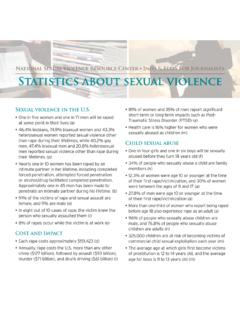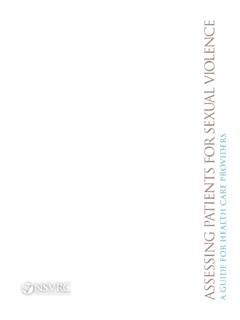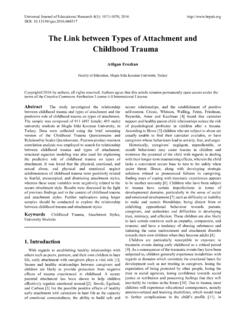Transcription of Sexual Revictimization - National Sexual Violence Resource …
1 NSVRC 123 North Enola Drive, Enola, PA 17025 Toll free: 877-739-3895 RevictimizationResearch BriefThis research brief explores the correlation between childhood Sexual abuse (CSA) and subsequent Sexual victimization in adulthood. The articles below, published between 2000 and 2011, demonstrate the significant link between childhood and adulthood Sexual Revictimization , as well as related health problems. Review ArticlesLalor, K., & McElvaney, R. (2010). Child Sexual abuse, links to later Sexual exploitation/high-risk Sexual behavior, and prevention/treatment programs. Trauma, Violence , & Abuse, 11, 159-177. : This article reviews research literature on the incidence of CSA, with emphasis on the relation between CSA and later Sexual exploitation, and apply this information for successful CSA prevention.
2 Methods: The authors draw from approximately 128 international scholarly articles on CSA published between 1979 and 2009. Key Results y Numerous studies suggest that Sexual victimization in adolescence significantly increases the likelihood of Sexual victimization in adulthood. Studies suggest that Sexual victimization in childhood or adolescence increases the likelihood of Sexual victimization in adulthood between 2 and times. ySeveral researchers speculate that mediating factors caused by CSA contribute to higher risk of Sexual Revictimization . childhood abuse may interfere with normal development of interpersonal relatedness and affect regulation, which in turn decrease abuse victims awareness of danger.
3 Negative long-term effects of CSA may be attempts to avoid or cope with negative emotional states, but that such emotional avoidance can create challenges in recognizing danger cues. Some female CSA victims may associate sexuality with pain, punishment, and other negative outcomes, leading them to believe that coercion and trauma are normal aspects of Sexual relations. This, in turn, would leave CSA victims with a higher threshold of tolerance for coercive or forceful Sexual advances. yOther researchers speculate that social and cultural factors, rather than personal variables alone, contribute to Sexual Revictimization . Victims experiences can be framed in an ecological model that takes into account the role of individual history, family, larger social systems, and cultural norms and institutions in facilitating Sexual Revictimization .
4 Much of the literature on CSA 2 Revictimizationprevention emphasizes a holistic, ecological approach that addresses the various systemic forces influencing children s development. Application: This article provides researchers and stakeholders with information on the body of research on CSA, Sexual Revictimization , and CSA prevention efforts. It can alert stakeholders to vulnerable populations for Sexual Revictimization ( , CSA survivors, women involved in prostitution). Closing the gaps identified by this research can assist stakeholders in forging comprehensive CSA prevention campaigns. More information on prevention is available in the NSVRC information packet on CSA StudiesBalsam, K. F., Lehavot, K.
5 , & Beadnell, B. (2011). Sexual Revictimization and mental health: A comparison of lesbians, gay men, and heterosexual women. Journal of Interpersonal Violence , 26, 1798-1814. : This study sought to determine whether CSA increases the risk for adult Sexual assault among gay men, lesbian women, and heterosexual women. Additionally, it sought to determine what, if any relationship exists between gender, Sexual orientation, CSA, and adult Sexual victimization. Finally, it explores the relationship between Sexual Revictimization and adverse mental health outcomes, including substance use, suicidality, self-injury, eating disorders, and psychological distress. Methods: Researchers drew from questionnaires completed by 871 adult respondents, who consisted of 322 (37%) lesbian women, 214 ( ) gay men, and 335 ( ) heterosexual women.
6 Key Results: y of respondents reported CSA, and reported adult rape. Lesbians reported higher rates of both CSA (44%) and adult rape (15%) compared to gay men and heterosexual women. y of respondents who experienced CSA reported adult rape. Research Brief 3 y Respondents who reported both CSA and adult rape were more likely to report psychological distress, suicidality and self-injury than respondents who had never experienced Sexual victimization, or experienced either CSA or adult : This suggests that women who identify as heterosexual and women and men who identify as lesbian or gay experience similar rates of Sexual Violence Revictimization and resulting adverse mental health conditions. Service providers who assist Sexual assault victims should be cognizant of the needs of survivors of all Sexual orientations.
7 Additionally, collaboration between Sexual assault victim advocates, organizations serving gay and lesbian communities, drug and alcohol counseling/rehabilitation service providers, and mental health service providers may prove efficacious in better serving Sexual assault , M. C., Basile, K. C., Breiding, M. J., Smith, S. G., Walters, M. L., Merrick, M. T., Chen, J., & Stevens, M. R. (2011). National Intimate Partner and Sexual Violence Survey: 2010 summary report. Retrieved from the Centers for Disease Control and Prevention, National Center for Injury Prevention and Control: : This report charts the prevalence and characteristics of intimate partner Violence , Sexual Violence , and stalking in a sample of adult men and women.
8 Additionally, the report discusses Revictimization patterns and health consequences correlated with experiencing these forms of : The study draws data from random telephone interviews with 16,407 adults (9,086 women and 7,421 men) in 2010. Subjects were asked about lifetime and 12-month exposure to Sexual Violence , stalking, and intimate partner Violence (including psychological aggression, physical Violence , and Sexual Violence ), as well as adverse emotional responses, mental health problems, and physical health Results: of female respondents and of male respondents reported experiencing rape (including completed forced penetration, attempted forced penetration, and completed alcohol or drug facilitated penetration) during their Revictimization y of female respondents and of male respondents reported experiencing Sexual Violence other than rape during their lifetimes.
9 Y Among female respondents who reported experiencing a completed rape before age 18, also experienced a completed rape as an adult, compared to of women who did not experience rape before age 18. Too few men reported experiencing rape in adulthood to examine Revictimization : This study reminds stakeholders that women report high lifetime prevalence of Sexual victimization (including but not limited to rape), and that rape before age 18 is significantly correlated with adult rape among women. Stakeholders can target both primary and secondary prevention efforts at youth so as to prevent both initial and later adult Sexual victimization. Desai, S., Arias, I., Thompson, M. P., & Basile, K. C. (2002). childhood victimization and subsequent Revictimization assessed in a nationally representative sample of women and men.
10 Violence and Victims, 17, : This study sought to determine whether childhood physical or Sexual abuse increased victims risk for physican or Sexual Revictimization in : The study drew data from the National Violence Against Women Survey, which obtained data from 8,000 adult men and 8,000 adult women between November 1995 and May 1996. Respondents answered questions about physical and Sexual victimization in childhood and Results: y childhood Sexual victimization was reported by 7% of women and 2% of men. Adult Sexual victimization was reported by of women and 1% of men. Finally, of women and .4% of men reported having experienced Sexual abuse by an intimate partner. y Women who experienced CSA were twice as likely to report adult Sexual victimization as women who did not experience CSA.















